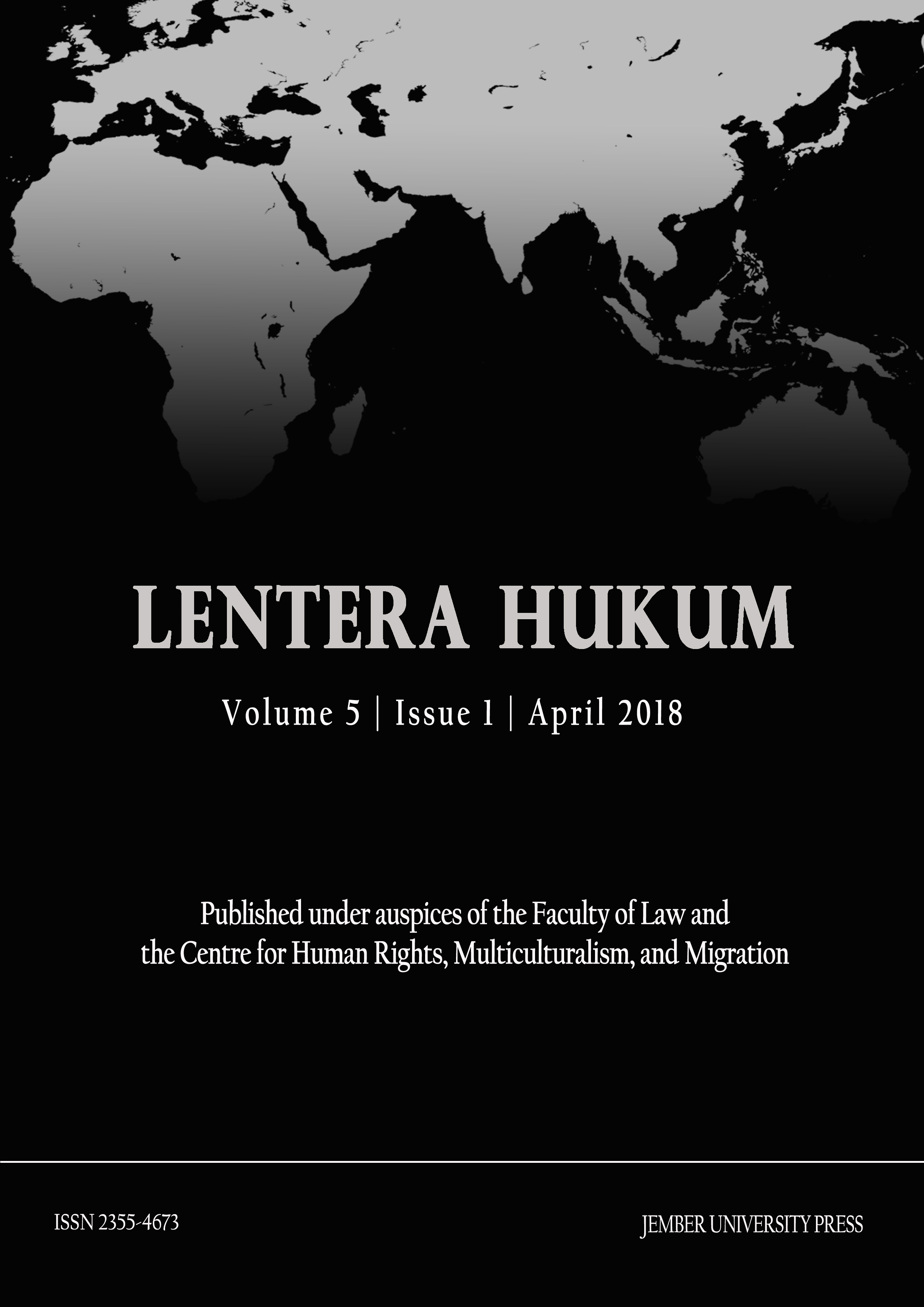Responsibility to Protect sebagai Bentuk Perlindungan Hak Asasi Manusia di ASEAN
Abstract
Association of Southeast Asian Nations (ASEAN) established on August 8, 1967 still accords to the principle of non-intervention which has been arranged in the ASEAN Charter. This principle, however, has been debated among ASEAN members, specifically when it is dealt with human rights. While the instutionalization is one of ASEAN’s achievements, human rights become one of pivotal issues in Southeast Asia which subsequently raises questions on the commitment of ASEAN to support the Responsibility to protect at the Summit on 2005. This article revisits the responsibility to protect in international law which is accorded to international customary law of Article 38 paragraph (1) of the Statute of International Court of Justice (ICJ). By using legal research, this article asserts that the responsibility to protect is essentially applicable to be adopted by regional intergovernmental organization like ASEAN, though it was initially only adopted by the Security Council of the United Nations. But, the principle of non-intervention would be the primary barrier to applying it. Therefore, this article recommends to wielding power to the Security Council of the United Nations with respect to solving such problem at the ASEAN level with the following idea to include ASEAN as the UN member.
Keywords: Responsibility to protect, Human Rights, ASEAN
References
- International Coalition for The Responsibility to protect, ‘Sebuah Toolkit tentang Tanggung Jawab Melindungi’, hlm. 15.
- Santa Marelda Saragih, ‘Responsibility to protect: Suatu Tanggung Jawab dalam Kedaulatan Negara’ 2, Mei-Agustus 2011, hlm. 2.
- International Coalition, supra note 1, hlm. 6.
- John Mark Lyi, Humanitarian Intervention and the AU-ECOWAS Intervention Treaties under International Law: Towards a Theory of Regional Responsibility to protect (Springer International Publishing AG Switzerland 2016), hlm. 65.
- Lihat Pasal 2 ayat 7 UN Charter.
- John Mark Lyi, supra note 4, hlm. 42.
- Eric A Heinze, Waging Humanitarian War: The Ethics, Law and Politics of Humanitarian Intervention (State University of New York Press, Albany 2009), hlm. 8.
- Ion Panait, ‘From Human Security to responsibility to protect’ (2014) Lucian Blaga University, hlm. 2.
- Sekretaris PBB Periode 1997-2006.
- Pernyataan asli Kofi Annan: ...cast in stark relief the dilemma of so-called “humanitarian intervention”. On the one hand, is it legitimate for a regional organisation to use force without a UN mandate? On the other, is it permissible to let gross and systematic violations of human rights, with grave humanitarian consequences, continue unchecked? The inability of the international community to reconcile these two compelling interests in the case of Kosovo can be viewed only as a tragedy. Dikutip di Stephen P Marks and Nicolas Cooper, ‘The responsibility to protect: Watershed or Old Wine in a New Bottle’ 2, Issue 1, September 2010 O. P. Jindal Global University, hlm. 5.
- Seorang mantan diplomat asal Sudan yang menjadi Perwakilan Khusus PBB untuk Masalah Pengungsi Internal.
- Suatu lembaga yang dibentuk oleh Pemerintah Kanada pada bulan September 2000 yang dipimpin oleh sejumlah ahli internasional seperti Gareth Evans dan Mohammed Sahnoun guna mengembangkan prinsip R2P atas dasar hasil pemikiran Dr. Francis Deng.
- Rahayu, ‘Eksistensi Prinsip Responsibilty to Protect Dalam Hukum Internasional’ Jilid 41 No. 1 Januari 2012 Jurnal MMH 3.
- Sekjen PBB yang menjabat dua periode berturut-turut dimulai dari tanggal 1 Januari 2007 sampai 31 Desember 2016.
- Tiga pilar ini disampaikan dalam laporan Ban Ki Moon pada tahun Januari 2009 yang berjudul “Implementing responsibility to protect”. Laporan ini merupakan dokumen pertama PBB yang paling lengkap mengenai prinsip R2P dimana, Sekjen PBB ini mengungkapkan rencana-rencananya untuk menerapkan “Responsibility to protect” dalam bentuk tindakan nyata.
- Pasal 2 ayat (7) UN Charter “...........but this principle shall not prejudice the application of enforcement measures under Chapter VII”.
- Setelah diratifikasi 10 negara, ASEAN charter mulai berlaku pada tanggal 15 Desember 2008. Setelah Piagam ini berlaku, maka kesepuluh negara terikat dengan apa yang diatur oleh Piagam ASEAN.
- Christine Susanna Tjhin, ‘Menjalin Demokrasi Lokal dengan Regional: Membangun Indonesia, Membangun Asean’ (Centre for Strategic and International Studies 2005), hlm. 6.
- Irma D Rismayati, ‘Manusia Perahu Rohingya: Tantangan Penegakan HAM di ASEAN’ 1 Oktober 2009, hlm. 17.
- Direktorat Jenderal Kerja Sama ASEAN Kementerian Luar Negeri RI, Ayo Kita Kenali Asean (2011), hlm. 44.
- Departement of Peacekeeping Operations United Nations Secretariat, United Nations Peackeeping Operations: Principles and Guideliness, New, York. (2010), hlm. 10.
- Harjono, ‘Perjanjian Internasional dalam Sistem UUD 1945’ 04, Januari-April 2012 Jurnal Opinio Juris, hlm. 14.
- Sefriani, ‘Pengakhiran Sepihak Perjanjian Perdagangan Internasional’ 2 Nomor 1 Tahun 2015 Jurnal Ilmu Hukum, hlm. 17.
- Kholis Roisah, Hukum Perjanjian Internasional: Teori dan Praktek (Setara Press 2015), hlm. 67.
- Bunyi asli Pasal 49 “Unless otherwise provided for in this Charter, the ASEAN Coordinating Council shall determine the terms of reference and rules of procedure and shall ensure their consistency”.
- Ludiro Madu, ‘Pelembagaan Regional Mengenai Hak Asasi Manusia Di ASEAN’ 5 Edisi 1/April 2016 Jurnal Hubungan Internasional, hlm. 7.
- Elfia Farida, ‘Peluang dan Tantangan ASEAN Menuju Komunitas ASEAN 2015’ Jilid 41 No. 3 Juli 2012 Jurnal MMH, hlm. 2.
- Endah Rantau Itasari, ‘Memaksimalkan Peran Treaty of Amity and Cooperation in Southeast Asia 1976 (TAC) dalam Penyelesaian Sengketa di ASEAN’ 1 Nomor 1 Februari 2015 Jurnal Komunikasi Hukum, hlm. 7.
- Scott Burchill and Andew Linklater, Teori-Teori Hubungan Internasional (Nusa Media Ujung, Bandung, 2009), hlm. 242.
- William D Coplin and Marsedes Marbun, Pengantar Politik Internasional; Suatu Telaah Teoritis (Kedua, Sinar Baru, 1992), hlm. 436.
- Merdi Hajiji, ‘Relasi Hukum dan Politik dalam Sistem Hukum Indonesia’ 2 Nomor 3 Desember 2013 Jurnal Rechtsvinding, hlm. 2.
- Mahfud MD, Politik Hukum di Indonesia (Raja Grafindo Persada, 2012), hlm. 4.
- Wahyudi Djafar, Ardimanto Putra and Hilman Handoni, ‘Laporan Memperkuat Perlindungan Hak Asasi Manusia di Asean’ (International NGO Forum on Indonesian Development, 2014) Laporan Penelitian, hlm. 58.




